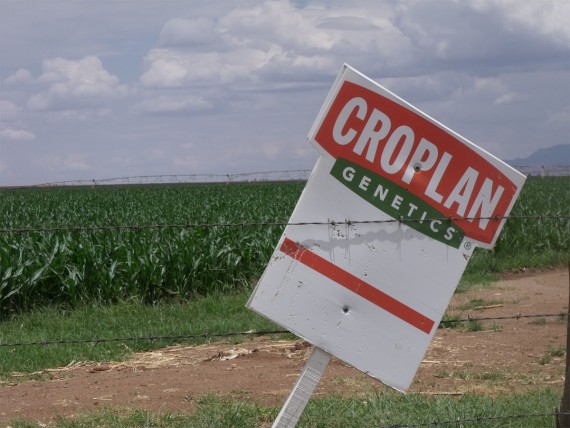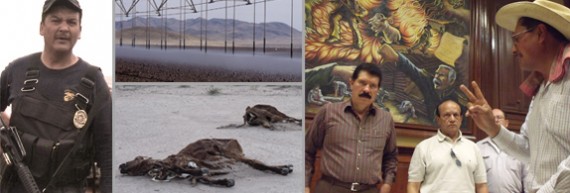Page 3

In the mid-1990s, when a three-decade period of high precipitation was coming to a close, Mennonite farmers began organizing new colonies to transform desert lands to farms. In part, the shift by the Mennonites from traditional to more capital-intensive farm practices explains this new colonization of remote tracts of desert. The high birth rate among Mennonite families and the consequent need to expand also help explain this agricultural expansion.
As drought conditions became more common in Chihuahua, overgrazing by ranchers and ejidatarios became increasingly unsustainable. Massive cattle deaths—an estimated 400,000 in the last two years—persuaded many ranchers to sell their rangelands, mostly to Mennonites abut also to enterprising agro-capitalists from Sinaloa.
While the lack of rain combined with traditional unsustainable land management practices made ranching a losing proposition, these same nearly barren rangelands could be turned into farms by tapping aquifers with deep wells.
As Chihuahua and other northern states enter their third year of intense drought, tensions are building between those with relatively shallow wells (most ejidatarios and small individual producers called pequeños proprietarios) and the Mennonite communities that persist in drilling hundreds of new wells at unprecedented depths. The Mennonites, while leading the charge to convert overgrazed and drought-devastated rangelands in agricultural estates, are not alone.
Farmland is edging out the desert and grasslands throughout Chihuahua. Along the main highways and between the mountain ranges that divide it, the arid state is turning green with alfalfa, corn, sorghum and cotton, as well as new cash crops such as potatoes and chile.
Along toll highways that connect the cities of Juárez, Chihuahua and Cuauhtémoc, forsaken expanses of Chihuahuan Desert are now in bloom. When descending from mountain passes, formerly arid landscapes take on the appearance of agricultural enterprises in the US Midwest.
Neither the 2000-2004 drought nor the recent drought (considered the most severe in modern Mexican history) has stymied this rush to make the Chihuahua desert blossom with cash crops. Instead, drought has fostered the spread of agribusiness-type farming.
Over the past two decades, paralleling the expansion of the rural electric grid, deep irrigation wells have mushroomed in Chihuahua. Most of the new wells are three to five times the depth of the older wells, tapping the subterranean water basins at depths regularly exceeding 800 feet and often reaching 1,200 feet.
Most of the wells drilled for new agricultural projects can at best be characterized as “irregular”—meaning essentially that they are illegal either because the well permits don’t exist, were the result of bribes, or are forged, cloned or copied. Although no one knows for certain, there are at least 1,500 illegal wells sucking water from rapidly shrinking water basins.
Farmers and water experts in Chihuahua say that on average the level of groundwater has dropped 5-10 feet annually in the areas of new agricultural production over the past couple of decades. In Chihuahua, the lack of reliable information about the size and depletion rates of the aquifers also complicates an assessment of the severity of the current crisis, as does the systemic corruption and lack of transparency and accountability at all levels of government.
Yet the figures that do exist are alarming, although mostly ignored by government and producers alike.
Carlos “Chacho” Ramírez is president of the COTAS water committee in Ascensión, a border municipality that includes Palomas and three new Mennonite colonias.
“There is no life without water,” he says, “and the frightening reality here is that we don’t know how much longer our groundwater will last.” Given the rapid drop in the water table, as much as six meters (almost 20 feet) annually in areas around the Mennonite settlements, Ramírez says he wouldn’t be surprised if the intensely exploited aquifer ran dry in five years.
This vast border municipio (county) of Ascensión is emblematic of the water crisis facing most of Mexico’s north, including the states of Sonora, Coahuila, Zacatecas, Durango and Chihuahua—and by extension into the border states of Arizona, New Mexico and west Texas.
“The problem, of course,” says Ramírez, “is the increasing lack of water—both in the form of surface flows and groundwater, and realistically there is nothing to stave off the crisis, only mitigate it perhaps as part of a new survival strategy.”
The severity of the water crisis in Ascensión is directly related to the proliferation of deep wells for irrigated agriculture. Back in 1979 the federal government declared that Ascensión was already unsustainably exploited—meaning that the annual recharge didn’t compensate for the annual exploitation of groundwater.
At that time, this vast border municipality had some 350 wells. Today, the area has an estimated 1,750 wells. And the depths of the new wells are at least 400-500 feet, according to Ramírez, while the average well depth was only 80 feet 35 years ago.
According to the Mexican federal government, the aquifer beneath Ascensión is one of the 15 in Chihuahua that is dangerously overexploited. It is only a matter of time—most close observers estimate 5-10 years—before it will be completely drained of accumulated water reserves.
The drug-war crisis in Chihuahua seems likely to be overshadowed in the near future by the escalating water crisis and accompanying water wars.
Most everyone bemoans the increasingly arid environment, echoing the common observation that never before have they seen such an intense drought: “Not in my life.” “Never before in our history.” “The mountains no longer bring the rain, and the land is dead.” Over and over I have heard these and similar laments.
In his 2011 book A Great Aridness, author William deBuys contends that the North American Southwest—which he defines as including northwestern Mexico—promises to be the “center stage for the continent’s drama of climate change.” Most models of the impact of climate change predict that this transborder Southwest “will outstrip other regions in both the rate and the amount of change,” observes deBuys.
Although human-induced climate change is a widely accepted fact in Chihuahua, there are exceptions. Chatting with a Mennonite farmer in the new border colonia of El Berrendo, before crossing into the New Mexico Bootheel at the Antelope Wells port-of-entry, the lifelong farmer, one of the founders of the new colony, explained, when asked about his views about God, the natural world and climate change: “We don’t know about the sun. We don’t know about the moon. We don’t know about the water beneath us. These are the things of God, and we are only here to use these natural resources the best we can to be productive.”
Like so many other close observers of rural development and environmental conditions in Chihuahua, however, Martín Solís is preoccupied by the frightening acceleration of the region’s crisis. “The future of Chihuahua is at risk,” he said. “Rural Chihuahua especially is threatened, and in as few as five years the rural economy—ranching and farming—might shut down if we don’t do something now.”
Wherever one travels—through the heart of the great desert, past the parched and rapidly disappearing grasslands, into the sierra, and off the traffic corridors into the colonias of the capital city and Juárez—life in Chihuahua is threatened.
The essential aridness that has defined the region—giving rise to the Páquime civilization a thousand years ago and birthing the Mexican Revolution a hundred years ago—is threatened by a still greater aridness that is marked by higher temperatures, more severe droughts, and rapidly depleting aquifers.
(Originally Published in The Desert Exposure, April 2013)




Responses to “The Coming Water Wars in Mexico”